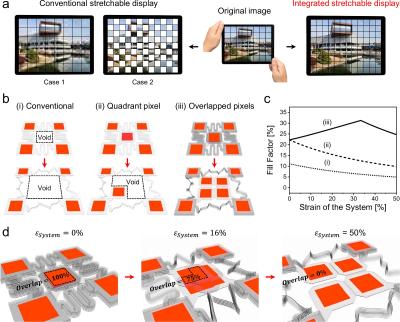Researchers from Korea’s Advanced Institute of Science and Technology (KAIST) have designed a new integrated stretchable OLED display, that utilize overlapping qaudrant pixels in voids. The overlapped pixels are vertically aligned to optically function as a single pixel in the original state. Upon stretching, these pixels are spatially separated and become individually visible, thereby increasing the fill factor.
The researchers have designed a reliable multilayered structure utilizing patterned adhesive and the deposition of patterned electrodes. They have deposited a passive-matrix (PMOLED) stretchable display, consisting of a 3 × 2 array with one central pixel and four quadrant pixels per unit. This display successfully displayed various letters clearly in both the original and stretched states.
Stretchable displays offer unique challenges, and researchers (and companies) are offering unique ways to enable the display to still display high quality images while stretched. In the past we have seen very interesting stretchable display demonstrations, research activities, in both OLED and microLED technologies, which we will detail below.
Last year we reported on a research Kyung Hee University in Korea that demonstrated highly efficient stretchable OLED devices by incorporating the prestretched elastomer with optical adhesive film. This so-called Geometrical Stretchable OLED (GSOLED) device enhances the efficiency of the OLEDs with the light extraction phenomenon brought by nanowavy corrugated structures. Furthermore, GSOLED shows stability in stretchable conditions and displays narrower emission spectrum with improved color purity.
